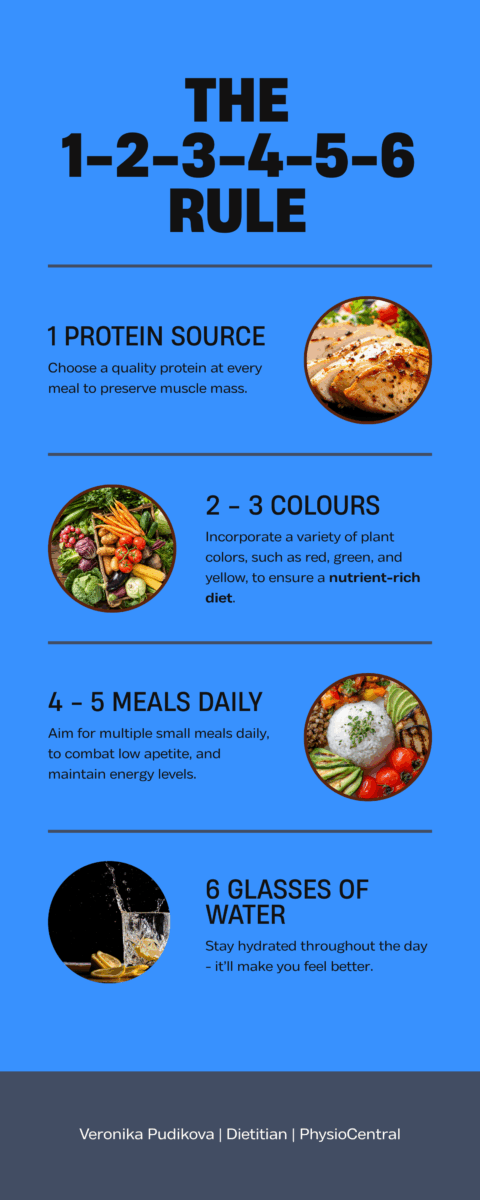A step-by-step dietitian guide to prevent nutrient deficiencies, manage side effects and eat safely while taking GLP-1 receptor antagonist weight-loss medications.
Medications like Wegovy and Mounjaro are powerful tools for weight management and metabolic health.
They work by mimicking natural gut hormones that slow digestion, reduce appetite, and help the body manage blood sugar more effectively.
While these changes support healthy weight loss, they can also make it easier to under-eat or miss important nutrients if you’re not paying attention.
Without balanced nutrition, people can experience fatigue, muscle loss, hair thinning, digestive issues, nausea, and nutrient deficiencies.
The good news? With a few smart strategies, you can stay nourished, protect your strength, avoid some of those nasty side effects, and get the most benefit from your medication – safely.
Common Nutrition Risks
Eating less food often means fewer nutrients. Here are some of the most common deficiencies seen with GLP‑1 medications:
- Low protein – causes muscle loss, fatigue and slower metabolism.
- Iron deficiency – can lead to low mood, tiredness and poor exercise recovery.
- Calcium & vitamin D shortfall – raises risk of weak bones and fractures.
- Vitamin B12 deficiency – linked to fatigue, tingling and mood or memory issues.
- Fibre gaps – increase risk of constipation and bloating.
- Electrolyte losses – may cause cramps, dizziness or dehydration (especially with nausea or diarrhoea).
How to Eat Safely on GLP‑1 Medications
1 Source of Protein at Every Meal
Protein is essential to preserve muscle mass and keep you feeling strong. Include foods like eggs, fish, lean meats, chicken, tofu or Greek yoghurt in each meal and snack. If you get full easily, start by eating the protein component of the meal first.
Examples:
- Breakfast: 1 egg with a slice of wholegrain toast.
- Lunch: Palm‑sized portion (≈ 80 g cooked) of chicken with salad.
- Dinner: 65 g lean beef stir‑fried with vegetables and rice.
- Snacks: A small handful of nuts or 1/2 cup of Greek yoghurt.
2–3 Colours of Plants at Every Meal
Colourful vegetables, fruit, nuts and seeds provide fibre, antioxidants and essential micronutrients. Each colour on your plate brings something unique.
Suggestions:
- Breakfast idea: Add the rainbow to a smoothie – spinach, frozen mango, chia seeds.
- Lunch idea: Roasted pumpkin, sweet potato and beetroot dressing up a grain bowl.
- Dinner idea: Hide pureed zucchini, bell peppers, spinach and cauliflower in your pasta sauce.
- Snack idea: Vegetable sticks with your favourite dip or a handful of berries.
4–5 Meals Each Day
Skipping meals can lead to fatigue, dizziness and nutrient deficiencies. A regular balanced eating routine maintains energy and prevents severe under‑nutrition. Even if your portions are small, aim for at least three mini‑meals and healthy snacks.
Routine suggestion:
- Breakfast within 2 hours of waking.
- Keep to consistent meal times.
- Set reminders to not forget.
6+ Glasses of Water Each Day
Slower digestion and reduced fibre intake can mean a higher chance of constipation. Drinking 6–8 glasses of water, along with other fluids (≈ 2 – 3 L total), keeps things moving comfortably and reduces dehydration. Limit alcoholic, sugar‑sweetened and carbonated beverages and sip steadily rather than all at once.
Fluids that count: herbal infusions (peppermint, chamomile), tea or coffee (in moderation), milk or fortified plant milks, plain yoghurts, soups and broths, smoothies and fruit juices.
A Simple Guideline

Personalising Your Plan
Everyone’s response to GLP‑1 medications is different. Dietitians consider:
- Symptoms & tolerance: adjust texture, meal size and fibre type for nausea, reflux or constipation.
- Appetite window: time protein and nutrient intake when you can eat comfortably.
- Activity level: adjust carbohydrate timing around workouts to maintain energy.
- Medication timing: adapt injection‑day meals for better tolerance and hydration.
- Blood tests: track iron, B12, vitamin D and electrolytes with your GP to guide diet and supplementation.
- Allergies or intolerances: swap ingredients safely while keeping meals balanced.
- Lifestyle factors: plan around your schedule, cooking skills and budget for sustainable results.
Oral Nutrition Supplements
Supplements may be needed to fill nutritional gaps that food alone cannot. Talk to your dietitian about tailored options based on your blood tests and intake.
When to See a Dietitian
Book an appointment if you notice any of the following:
- Weight loss is too fast or too slow: more than 2 % of body weight per week for 2+ weeks, or no change after 4 weeks.
- Persistent side effects: such as nausea, constipation, reflux or poor appetite.
- Difficulty managing food: skipping meals, relying on takeaway or struggling to plan.
- Long‑term goals: like transitioning off medication or maintaining results sustainably.
Final Thoughts
GLP‑1 medications like Wegovy and Mounjaro can transform health when paired with the right nutrition. But the medicine isn’t a replacement for food – it works with food.
A dietitian can help fine‑tune your meal timing, protein balance and hydration so your body stays strong and nourished while you lose weight safely. And minimise side effects!
With the right approach, medicated weight loss becomes not just effective but sustainable and supportive of your long‑term wellbeing.

Veronika Pudikova is a Dietitian at PhysioCentral. Miranda. Sutherland Shire